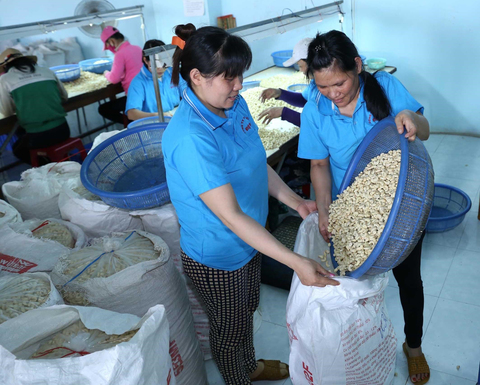
Workers at Viet Hung Co Ltd pack cashew nuts. — VNA/VNS Photo Vu Sinh
The agricultural sector earned US$32.6 billion from agro, fishery and forestry exports during the first 10 months, up 8.1 per cent year-on-year, according to the Ministry of Agriculture and Rural Development (MARD).
Exports of key farm produce hit $16.4 billion from January-October, 2.3 per cent higher than the same period last year, reported MARD’s Agro Processing Market Development Authority.
Earnings from seafood, husbandry and forestry products were estimated at $7.24 billion, $460 million and $7.6 billion, rising 6.2 per cent, 9.5 per cent and 16.3 per cent, respectively.
Over the 10-month period, Viet Nam pocketed $2.6 billion from shipping 5.2 million tonnes of rice abroad, an increase of 1.7 per cent in volume and 14.1 per cent in value year-on-year.
Strong growth in rice export value was seen in Indonesia, Iraq, the Philippines and Malaysia.
Coffee export revenue also bounced back after a steep decline. About 1.57 million tonnes of coffee were sold to foreign countries for $2.98 billion in the reviewed period, a year-on-year increase of 21.3 per cent in volume and 0.9 per cent in value.
Regarding fruit and vegetables, Viet Nam exported around $3.3 billion worth of products, marking a 15.5 per cent year-on-year rise. Exports of cassava reached 1.92 million tonnes for $739.6 million, down 9.78 per cent in volume but up 16.1 per cent in value.
In contrast, a decline in export value was seen in pepper (33.4 per cent), rubber (7.3 per cent) and tea (7.7 per cent).
Export promotions
Viet Nam has integrated further into the world economy by joining new free trade agreements (FTAs), opening up more opportunities for agricultural, forestry and fishery exports for the nation, according to MARD.
The domestic agricultural sector planned to continue large-scale production development in the direction of modernisation to increase added-value for sustainable agricultural development.
MARD would also regularly co-ordinate with other ministries, sectors, associations and enterprises to closely monitor the production and consumption of agro-forestry products to formulate policies to expand the market and remove difficulties to ensure effective consumption of agricultural products for businesses and producers, according to the Minister of Agriculture and Rural Development, Nguyen Xuan Cuong.
The ministry was ready to work with enterprises to develop quality agricultural products for export. It was important to co-ordinate to implement efficient policies, said the Deputy Minister of Agriculture and Rural Development, Tran Thanh Nam.
Tran Thanh Hai, deputy director of the Export-Import Department under the Ministry of Industry and Trade (MoIT), said that businesses needed capital and land but also Government policies to encourage the development of the sector. The Government needed to create favourable conditions for the sector’s development.
Viet Nam has six major markets accounting for 77 per cent of total exports: China, the US, Japan, South Korea, ASEAN and the EU.
The dependence on some markets was a matter to be considered, but could be seen as a reason for Viet Nam to diversify its export markets. The MoIT would support enterprises looking for new export markets, Hai said.
Viet Nam was the fifth largest farming exporter in Southeast Asia and the fifteenth largest in the world, according to MARD.
From 2016 to 2018, total the export value of agriculture, forestry and fishery products was estimated to reach $109.21 billion, an average increase of 12.17 per cent and higher than the rate of 9.7 per cent set from 2011-15, reported Hai quan (Customs) newspaper.
During that period, 10 commodities reached export value of at lease $1 billion, including rice, rubber, coffee, pepper, cashew, cassava, fruit, vegetables, wood and wooden products, fish and shrimp. Of which, five products gained an export value of $3 billion per each: fruit, cashew nuts, coffee, shrimp and wooden furniture.
In terms of export markets, Vietnamese agricultural products are available in more than 180 countries and territories, including the 10 largest markets: China, the US, Japan, S Korea, Germany, the Netherlands, the UK, Australia, Malaysia and Italy.
MARD has focused on developing markets for agricultural products, and has actively co-ordinated with relevant agencies to promote exports of high quality products to remove technical barriers for markets such as the US, Australia and Japan.— VNS